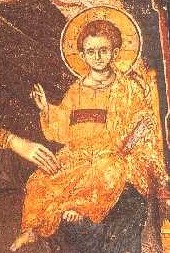
Photographs: Christos Theodorakopoulos
Photographs courtesy of the elder Hierotheos.
From I. M. Hatziphotes' book: The Macedonian School, the School of Panselenos (1290-1320), Publisher: The National Foundation for Youth, Athens, 1995.
 |
THE LADY THEOTOKOS (ΜΡ ΘΥ)
Classic composition of the Mother of God enthroned with the infant Christ in her arms.
|
 |
JESUS CHRIST
One of the most imposing and significant representations of Jesus Christ.
|
 |
A detail of work no. 9. The hands of the All-holy Lady and the infant Christ.
|
 |
The upper portion of work no. 9. The glance of the All-holy Lady and of the infant Christ bear witness to Panselenos' artistry in the elaboration of detail.
|
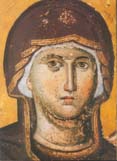 |
The Head of the All-holy Lady, a detail of work no. 9. The face displays youthful vigour as well as purity.
|
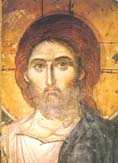 |
The Head of Jesus Christ, detail of work no. 10.
The face of "Him Who is fairer than the children of men" simultaneously displays gladness and the divine attributes of the Lord Almighty.
|
 |
The infant Christ, detail of work no. 9.
|
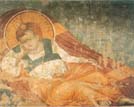 |
CHRIST AT REST
One of the types of portrayals of Christ as "reposing". In the other type He is shown between and angel holding the instruments of the Passion, and the All-holy Lady, who as a tender mother covers the baby Jesus with a sheet. This iconographic type is met with in Greece and the Balkans beginning in the 13th century. The type in the Protaton is simple; Jesus is shown partially reclining on a pallet, with His body inclining towards the right and His head leaning on the elbow of His right hand. This theme is entirely absent from the Cretan school, but exists in the more complex form in the catholicon of the Monastery of Stavronikita of Mount Athos, where it was painted by its leader, Theophanes the Cretan. This is taken from the 49th chapter of Genesis, verse 9: "having couched Thou liest as a lion, and as a whelp; who shall rouse Him up?" This work of Panselenos has been used as a model for many portrayals in the area of Greece and the Balkans.
|
 |
THE HONORABLE FORERUNNER(head)
All the harshness and hardness of the Honorable Forerunner's life in the desert is stamped upon his ascetic face, as well as the holiness of the one who baptized Christ. This work of Panselenos is the prototype of many later representations of the saint and chiefly of all those who followed or were influenced by the Macedonian school.
|
 |
The hand of the Holy Forerunner, a detail of work no. 17. The ascetic hand of the saint in the gesture of blessing, unfortunately damaged by cracks in the wall and other mishaps.
|
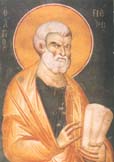 |
THE APOSTLE PETER
Preserved in relatively good condition, in contrast to the fresco of the Apostle Paul (see no. 20).
|
 |
THE APOSTLE PAUL
In spite of severe damage to the fresco, the expressiveness that Panselenos gave to the face of the chief apostle is preserved. The multiple scrolls denote the epistles that he addressed to the Churches and peoples in preaching the Christian message.
|
 |
The head of the Apostle Peter, a detail of work no. 19. Damage to the left eye distorts the absolute symmetry of the face.
|
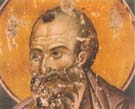 |
The head of the Apostle Paul, a detail of work no. 20. The ravages of time have left untouched the expression on the saint's face delineated by the artist through the movement he lends to the saint's mouth.
|
 |
SAINT ARTEMIOS
The face of the holy martyr is the likeness of Christ Himself. In the Interpretation of the Art of Painting Dionysios of Phournas indicates how he should be painted: "Saint Artemios is like Christ in form."
The saint was a duke and adminstrator in Alexandria; Constantine the Great had given him the office of patrician. He underwent frightful tortures, because he opposed Julian the Transgressor and his persecutions of the Christians of Antioch, where he went in order to stop him. They beheaded him with a sword. His relic was in the Church of the Holy Forerunner Oxeias in Constantinople. The resemblance of his face to that of Christ indicates his theosis.
|
 |
The head of Saint Artemios, a detail of work no. 23.
Damage to the right eye does not hinder the comparison between his facial characteristics and those of Jesus Christ (see no. 14).
|
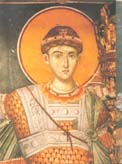 |
SAINT DEMETRIOS THE MYRRH-GUSHER
The patron saint and protector of Thessalonica, the Great-martyr Saint Demetrios the Myrrh-gusher with his well-known face, became the prototype for later hagiographers. He is represented by Panselenos standing upright holding a javelin in his right hand and a bow and two arrows in his left. Behind him his shield is visible. Panselenos decorates his hair with a diadem similar to Saint George's (see no. 26). Saint Demetrios lived in the time of Diocletian (284-304) and Maximianos (286-305) and was martyred, when the latter was in Thessalonica and the Christian youth Nestor defeated the beastly fighter Lyaeos by his prayers while he was imprisoned in Valaneio, next to the stadium. After this unexpected event, Maximianos did not confine himself to killing Nestor only, but also he gave the order to lance Saint Demetrios.
Today Thessalonica is adorned with the magnificent church built in honor of Saint Demetrios, where his holy relics are preserved; it is one of the greatest shrines of pilgrimage in the Balkans. The church is a basilica with five aisles, with a wooden roof. It was constructed, according to tradition, near the place where the saint was martyred. The construction of the original church is dated at 413. The present-day church is the product of restoration (1949) after the great fire of 1917, which destroyed the monument. During the long period from the 5th until the 20th century the building had undergone repairs, additions and renovations. In 1490 or 1491, during the reign of Sultan Vayazit II (1480-1512), the church was converted to a mosque with the name "Kasemie". The frescoes (1308) of the side chapel of Saint Euthymios are attributed to Panselenos.
Through actions taken by a contemporary Metropolitan of Thessalonica, Panteleimon II (+ 2003), the saint's relics were transferred to Thessalonica from San Lorenzo in Campo, Italy, where they had been transported during the Middle Ages.
|
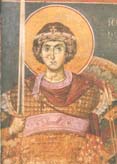 |
SAINT GEORGE THE TROPHY-BEARER
Protaton, Karyes Mount Athos. A work of Manuel Panselenos (1290).
In the youthful face of the Great-martyr Saint George the Trophy-bearer, the "saint on horseback of the Greek people", as Photios Kontoglou has characterized both him and Saint Demetrios, is imprinted all the holiness of his beautiful soul, committed wholly to Christ. Born in Cappadocia, he belonged to an important family. During the time of Diocletian (284-304) he became a member of the Order of Trivouni and rose to the rank of count. But when the emperor started the persecutions against the Christians, he opposed him with force, without fearing his threats. None of the horrible tortures that they stored up for St. George touched him, with the result that Alexandra, the wife of the emperor herself, came to the Christian faith. Enraged, Diocletian ordered them to take off his head.
Usually St. George is portrayed on horseback killing the dragon. Likewise, his martyrdom and his beheading are often portrayed. Here he is shown standing, gripping his sword with his right hand and with his left hand, his quiver and arrows. His shield is behind him, and his abundant hair is adorned by a diadem (which suggests his rank) like that of St. Demetrios'.
|
 |
The spear carried by Saint Demetrios, a detail of work no. 25. The saint keeps his right hand steadily lifted up holding the lance.
|
 |
The bow and arrows held by saint Demetrios, a detail of work no. 25. The left hand has been painted with delicacy in every detail. One feels that the saint is about to string one of the arrows in the bow.
|
 |
SAINT NICHOLAS THE WONDERWORKER
Protaton, Karyes, Mount Athos. The work of Manuel Panselenos (1290).
The patron saint of sailors is represented by Panselenos in a well-known, developed form, wearing hierarchical vestments and blessing. In the portion of the frescoes by the same artist preserved in Megisti Lavra, the saint's glance is turned slightly to the right, while his face is inclined to his left. In contrast, in the Protaton the saint is represented head-on.
|
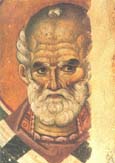 |
The head of Saint Nicholas, a detail of work no. 29. It was damaged, obviously, by the placement of a pipe.
|
|

